Tag: Visual edit |
No edit summary Tag: Visual edit |
||
| (8 intermediate revisions by the same user not shown) | |||
| Line 10: | Line 10: | ||
* ''The Trip'' |
* ''The Trip'' |
||
* ''Wildflower'' |
* ''Wildflower'' |
||
| − | The first set of recording sessions for the ongoing Teargarden by Kaleidyscope project, at Billy Corgan's brand new |
+ | The first set of recording sessions for the ongoing Teargarden by Kaleidyscope project, at Billy Corgan's brand new personal studio Pumpkinland II. With the intent of releasing one song per month for free over the course of 44 months, each song was recorded one at a time. The band now consisted of Corgan, Mark Tulin on bass and Mike Byrne on drums. |
| + | [[File:R-2289875-1274727824.jpeg.jpg|thumb|220x220px]] |
||
| + | “My desire is to release a song at a time beginning around Halloween of |
||
| + | this year, with each new release coming shortly after until all 44 are |
||
| + | out. Each song will be made available absolutely for free, to anyone |
||
| + | anywhere. There will be no strings attached,” Corgan writes. “Free will |
||
| + | mean free, which means you won’t have to sign up for anything, give an |
||
| + | email address, or jump through a hoop. You will be able to go and take |
||
| + | the song or songs as you wish, as many times as you wish.” |
||
| + | “The story of the album is based on ‘The Fool’s Journey’, as signified |
||
| ⚫ | |||
| + | in the progress of the Tarot,” Corgan writes. “It is my intention to |
||
| + | approach this by breaking down the journey of our life here into four |
||
| + | phases as made by these different characters; the Child, the Fool, the |
||
| + | Skeptic, and the Mystic.”<ref>Daniel Kreps, "Smashing Pumpkins Announce Free 44-Track Album!", Rolling Stone, September 16, 2009</ref> |
||
| + | |||
| ⚫ | |||
different. I didn't know that. Someone told me it means "deer garden." |
different. I didn't know that. Someone told me it means "deer garden." |
||
But I liked the idea of a tear garden—a crying garden.<ref>Marissa Moss, "Q&A: Billy Corgan of Smashing Pumpkins", Alt Press, July 2nd 2010</ref> |
But I liked the idea of a tear garden—a crying garden.<ref>Marissa Moss, "Q&A: Billy Corgan of Smashing Pumpkins", Alt Press, July 2nd 2010</ref> |
||
| + | |||
| + | Mr. Mark Tulin flew in from LAX a few hours ago and boy are his arms |
||
| + | tired, but we are putting him straight to work anyway. It looks like he will |
||
| + | playing a 1963 Fender Jazz bass through a 1963 Ampeg Portaflex flip-top |
||
| + | bassamp... Why? Because, well, it just sounds awesome! This has nothing to do |
||
| + | with the fact that I was born in 1963. Or maybe it does :) |
||
| + | |||
| + | Billy is playing a 1961 Les Paul Junior Special through a Sound City |
||
| + | Studio 20 amp, truly amazing sounding.<ref>Kerry Brown, glittercop blog, September 14, 2009</ref> |
||
| + | |||
| + | Lets |
||
| + | kick it off with a list and description of the microphones that we are using to |
||
| + | record the drums.. and away we go... |
||
| + | [[File:Mike 2.png|thumb|330x330px]] |
||
| + | 1. Inside the kick drum and about 3" from the beater we are using an AKG D112 (this mic is used for capturing the beater attack as it hits the drum head. We will use this sound as needed to cut through the mix once the guitars and bass have been tracked. |
||
| + | |||
| + | 2. On the outside of the kick and about 4" from drum head we are using 2 microphones a Beyer M88 TG (this is nice for that super tight low end punch) and an AKG D30 (This is the microphone that was used to get that huge kick drum sound used on many Led Zeppelin recordings. We call it of course the "Zep Mic".) |
||
| + | |||
| + | 3. On the top of the Snare we are using 2 microphones a Shure Sm57( this microphone has been used on almost every rock record ever recorded but we have found that with an AKG 414 EB placed by its side the snare has a bigger sound then usual and yet stays very true to the sound we hear in the room. |
||
| + | |||
| + | 4. On the Snare bottom we are using an AKG 414 EB (we use this mic as needed to grab more of the "snare" sound from the drum) |
||
| + | |||
| + | 5. The high hats called for a Neuman KM184 ( this microphone gives the hats a warm sound and it doesn't capture that splashy washy sound that drives me crazy) |
||
| + | |||
| + | 6. On the floor tom we placed an U47 Fet i (This mic really digs out the super low end of the tom and I love low end :) |
||
| + | [[File:Mike1.png|thumb|220x220px]] |
||
| + | 7. In front of the drum kit and about 4 feet away is a Telefunken Elam 251 (this particular microphone is very famous it was used by Steely Dan to record a lot of vocal tracks and it also works really great to capture the mid range and low end elements of the drums in the room.) |
||
| + | |||
| + | 8. For the high overheads microphones (left and right ) we are using Neuman's KM84 (again they do not capture all that "splashy washy" they are very warm and yet they grab enough of the bite when Mike really attacks the cymbals.) |
||
| + | |||
| + | 9. For the tight overhead microphone sitting very close to the kit we are using a stereo Telefunken SM2 (It is just great for the overall drum sound, my guess is that this microphone sounds a lot like what Mike hears from his perspective.) |
||
| + | |||
| + | 10. To round things out we are also using a mono overhead microphone an AKG C28 (it captures the hi end of the room and adds a little sparkle magic to the drum sound.<ref>Kerry Brown, glittercop blog, September 15, 2009</ref> |
||
| + | [[File:API SIDE.jpg|thumb|220x220px]] |
||
| + | |||
| + | |||
| + | With analog |
||
| + | recording there is a lot more involved then just going to tape. The microphone |
||
| + | preamps and the mixing desk play a huge roll in how a recording sounds. When |
||
| + | Billy announced that Smashing Pumpkins will release 44 songs under the title |
||
| + | Teargarden by Kaleidyscope I'm not sure if he mentioned that the goal is to |
||
| + | treat each song sonically different to best present its palette. Here are the |
||
| + | steps... Billy writes a song, we record a demo, listen back and find the |
||
| + | feeling that the song evokes and then visualize the picture that it paints. To |
||
| + | me, when a recording really works I "see it" as much if not more than |
||
| + | I "hear it." As we start the journey into the Teargarden I feel very |
||
| + | lucky to be working in a studio that has many unique and historical recording |
||
| + | consoles. |
||
| + | |||
| + | Pictured |
||
| + | above is the API console that we recorded the first song through. Just amazing |
||
| + | sounding... Very strong for guitars and I love the low end. Hendrix, Prince and |
||
| + | countless others have recorded on API boards. This particular board was owned by The Doobie Brothers |
||
| + | at one time..<ref>Kerry Brown, glittercop blog, September 23rd, 2009</ref> |
||
| + | |||
| + | After |
||
| + | we spent the first part of Saturday morning on scheduled studio maintenance we |
||
| + | set up some amps & cabs and started to dial in the guitar tone. WOW.... The |
||
| + | song just sounds extraordinary! We have been taking the needed time with the |
||
| + | track to make sure we get all the tones sounding just right... The bass,drums,congas |
||
| + | and Farfisa just sound amazing... none of that "we will fix it in the |
||
| + | mix" mentality going on here... We tracked the core rhythm section live as |
||
| + | a four piece and it translates really well in the studio. With no click track |
||
| + | used and after a handful of takes we found the magic... a very powerful, |
||
| + | natural sounding, voodoo snake charmer on acid, makes me want to fire dance |
||
| + | rhythm bed. To quote Mark Tulin "The music is reflecting |
||
| + | the passion of the process." Whatever the hell that means I don't know but |
||
| + | it sounds good! So first thing Monday morning Billy will start up on guitars...<ref>Kerry Brown, glittercop blog, September 20, 2009</ref> |
||
| + | [[File:YS metal.jpg|thumb|293x293px]] |
||
| + | It |
||
| + | looks like we are pulling a late one tonight. We spent most of the day tracking |
||
| + | mandolin and it seems we are making some real progress on song number 3. A few |
||
| + | minutes ago Ysanne Spevack picked up her Metal String Machine and was getting |
||
| + | ready to lay down some space symphony tones when out of nowhere a 12 string |
||
| + | banjo appeared in the control room and Billy started jamming on it. So, it |
||
| + | looks like we are going to be here for a long, long time tonight especially if |
||
| + | these crazy instrument keep popping out of thin air but, you gotta love the |
||
| + | magic! <ref>Kerry Brown, glittercop blog, October 5, 2009</ref> |
||
'''Billy Corgan on fan's reaction to Teargarden''': "One of the releases was called <em>A Stitch in Time</em>, which in my |
'''Billy Corgan on fan's reaction to Teargarden''': "One of the releases was called <em>A Stitch in Time</em>, which in my |
||
| Line 36: | Line 128: | ||
Return to [[Teargarden by Kaleidyscope/Oceania]] |
Return to [[Teargarden by Kaleidyscope/Oceania]] |
||
| + | |||
<references /> |
<references /> |
||
Latest revision as of 00:25, 25 September 2018
September-December 2009 - Pumpkinland II, Northbrook, IL[]
Produced by Billy Corgan and Kerry Brown; engineered by Bjorn Thorsrud
- Astral Planes
- A Song For a Son
- A Stitch In Time
- Teargarden Theme
- Widow Wake My Mind
- Caroline, Yes
- Shadowland
- The Trip
- Wildflower
The first set of recording sessions for the ongoing Teargarden by Kaleidyscope project, at Billy Corgan's brand new personal studio Pumpkinland II. With the intent of releasing one song per month for free over the course of 44 months, each song was recorded one at a time. The band now consisted of Corgan, Mark Tulin on bass and Mike Byrne on drums.
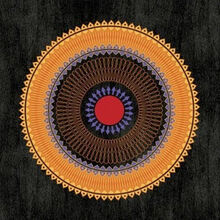
“My desire is to release a song at a time beginning around Halloween of this year, with each new release coming shortly after until all 44 are out. Each song will be made available absolutely for free, to anyone anywhere. There will be no strings attached,” Corgan writes. “Free will mean free, which means you won’t have to sign up for anything, give an email address, or jump through a hoop. You will be able to go and take the song or songs as you wish, as many times as you wish.”
“The story of the album is based on ‘The Fool’s Journey’, as signified in the progress of the Tarot,” Corgan writes. “It is my intention to approach this by breaking down the journey of our life here into four phases as made by these different characters; the Child, the Fool, the Skeptic, and the Mystic.”[1]
There's a place in Berlin called a Tiergarten, but it's spelled different. I didn't know that. Someone told me it means "deer garden." But I liked the idea of a tear garden—a crying garden.[2]
Mr. Mark Tulin flew in from LAX a few hours ago and boy are his arms tired, but we are putting him straight to work anyway. It looks like he will playing a 1963 Fender Jazz bass through a 1963 Ampeg Portaflex flip-top bassamp... Why? Because, well, it just sounds awesome! This has nothing to do with the fact that I was born in 1963. Or maybe it does :)
Billy is playing a 1961 Les Paul Junior Special through a Sound City Studio 20 amp, truly amazing sounding.[3]
Lets kick it off with a list and description of the microphones that we are using to record the drums.. and away we go...
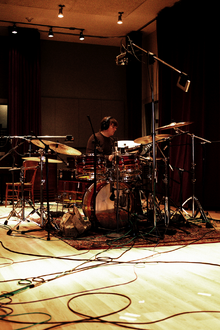
1. Inside the kick drum and about 3" from the beater we are using an AKG D112 (this mic is used for capturing the beater attack as it hits the drum head. We will use this sound as needed to cut through the mix once the guitars and bass have been tracked.
2. On the outside of the kick and about 4" from drum head we are using 2 microphones a Beyer M88 TG (this is nice for that super tight low end punch) and an AKG D30 (This is the microphone that was used to get that huge kick drum sound used on many Led Zeppelin recordings. We call it of course the "Zep Mic".)
3. On the top of the Snare we are using 2 microphones a Shure Sm57( this microphone has been used on almost every rock record ever recorded but we have found that with an AKG 414 EB placed by its side the snare has a bigger sound then usual and yet stays very true to the sound we hear in the room.
4. On the Snare bottom we are using an AKG 414 EB (we use this mic as needed to grab more of the "snare" sound from the drum)
5. The high hats called for a Neuman KM184 ( this microphone gives the hats a warm sound and it doesn't capture that splashy washy sound that drives me crazy)
6. On the floor tom we placed an U47 Fet i (This mic really digs out the super low end of the tom and I love low end :)
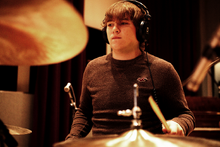
7. In front of the drum kit and about 4 feet away is a Telefunken Elam 251 (this particular microphone is very famous it was used by Steely Dan to record a lot of vocal tracks and it also works really great to capture the mid range and low end elements of the drums in the room.)
8. For the high overheads microphones (left and right ) we are using Neuman's KM84 (again they do not capture all that "splashy washy" they are very warm and yet they grab enough of the bite when Mike really attacks the cymbals.)
9. For the tight overhead microphone sitting very close to the kit we are using a stereo Telefunken SM2 (It is just great for the overall drum sound, my guess is that this microphone sounds a lot like what Mike hears from his perspective.)
10. To round things out we are also using a mono overhead microphone an AKG C28 (it captures the hi end of the room and adds a little sparkle magic to the drum sound.[4]
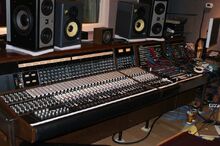
With analog
recording there is a lot more involved then just going to tape. The microphone
preamps and the mixing desk play a huge roll in how a recording sounds. When
Billy announced that Smashing Pumpkins will release 44 songs under the title
Teargarden by Kaleidyscope I'm not sure if he mentioned that the goal is to
treat each song sonically different to best present its palette. Here are the
steps... Billy writes a song, we record a demo, listen back and find the
feeling that the song evokes and then visualize the picture that it paints. To
me, when a recording really works I "see it" as much if not more than
I "hear it." As we start the journey into the Teargarden I feel very
lucky to be working in a studio that has many unique and historical recording
consoles.
Pictured above is the API console that we recorded the first song through. Just amazing sounding... Very strong for guitars and I love the low end. Hendrix, Prince and countless others have recorded on API boards. This particular board was owned by The Doobie Brothers at one time..[5]
After we spent the first part of Saturday morning on scheduled studio maintenance we set up some amps & cabs and started to dial in the guitar tone. WOW.... The song just sounds extraordinary! We have been taking the needed time with the track to make sure we get all the tones sounding just right... The bass,drums,congas and Farfisa just sound amazing... none of that "we will fix it in the mix" mentality going on here... We tracked the core rhythm section live as a four piece and it translates really well in the studio. With no click track used and after a handful of takes we found the magic... a very powerful, natural sounding, voodoo snake charmer on acid, makes me want to fire dance rhythm bed. To quote Mark Tulin "The music is reflecting the passion of the process." Whatever the hell that means I don't know but it sounds good! So first thing Monday morning Billy will start up on guitars...[6]
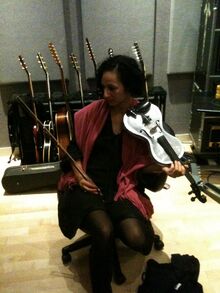
It looks like we are pulling a late one tonight. We spent most of the day tracking mandolin and it seems we are making some real progress on song number 3. A few minutes ago Ysanne Spevack picked up her Metal String Machine and was getting ready to lay down some space symphony tones when out of nowhere a 12 string banjo appeared in the control room and Billy started jamming on it. So, it looks like we are going to be here for a long, long time tonight especially if these crazy instrument keep popping out of thin air but, you gotta love the magic! [7]
Billy Corgan on fan's reaction to Teargarden: "One of the releases was called A Stitch in Time, which in my estimation is a pretty good song that could have very much fit on many Smashing Pumpkins' albums. I was reading about it as if it was the worst piece of s–t they'd ever heard, and I'm like, 'My god, it's just an acoustic song. How bad can it be?' "[8]
I was just talking about that: some of the hardcore Smashing Pumpkins fans don't think very much of that song, and I don't understand why. I think it's a very strong song.
I also think it fits well with some of my other acoustic material, like "Disarm" and things like that. It's very hard to write an acoustic song that has a narrative just within the acoustic form, if that makes sense, where the song can just hold up as an acoustic song and not just be, like, a nice song that you're playing acoustically. I sort of look at them differently. And I see it in that way. Maybe people don't like the production on it, I don't know. But, yeah, I really like it. It's one my favorite songs.[9]
Return to Teargarden by Kaleidyscope/Oceania
- ↑ Daniel Kreps, "Smashing Pumpkins Announce Free 44-Track Album!", Rolling Stone, September 16, 2009
- ↑ Marissa Moss, "Q&A: Billy Corgan of Smashing Pumpkins", Alt Press, July 2nd 2010
- ↑ Kerry Brown, glittercop blog, September 14, 2009
- ↑ Kerry Brown, glittercop blog, September 15, 2009
- ↑ Kerry Brown, glittercop blog, September 23rd, 2009
- ↑ Kerry Brown, glittercop blog, September 20, 2009
- ↑ Kerry Brown, glittercop blog, October 5, 2009
- ↑ National Post, June 18th, 2012
- ↑ Will Harris, "A Chat With Billy Corgan", Bullzeye, July 15th, 2010